ByJoe Zadehphotos byChris Bethell
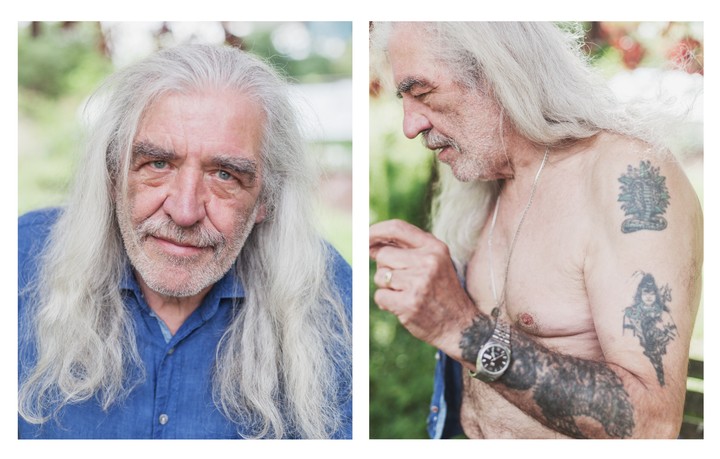
Exjíbaro de LSD, Smiles
Two months ago I was standing in a pub in south London on a Saturday afternoon, having a conversation with a photographer. While desperately dredging my mind for a half-decent anecdote, I decided to re-tell a story I’d read on the internet the day before. It was about these remote villages in Wales, which, in the 1970s, had become the home of a psychedelic empire of LSD producers and dealers.
The group was modelled as a cell structure, which meant few of them were aware of each other’s existence (so that if one was arrested, the rest could continue uninterrupted). And yet despite that, a remarkable number of them all chose to base themselves in the exact same remote region of mid-Wales. Something about the area drew them in.
By the time they were busted, in 1976, they were supplying 90 percent of all LSD in Britain and 60 percent of all LSD around the world (although subsequent reports suggest these figures may have been slightly sweetened by the authorities to give the investigation some tabloid wow factor). Many of them weren’t drug manufacturers and dealers in the 21st century sense. They were authors, chemists and free-thinking visionaries who – yes, liked the money – but also firmly believed that if they flooded British society with 99.07 percent pure LSD it would truly change the way people think about politics, war, love and mother nature.
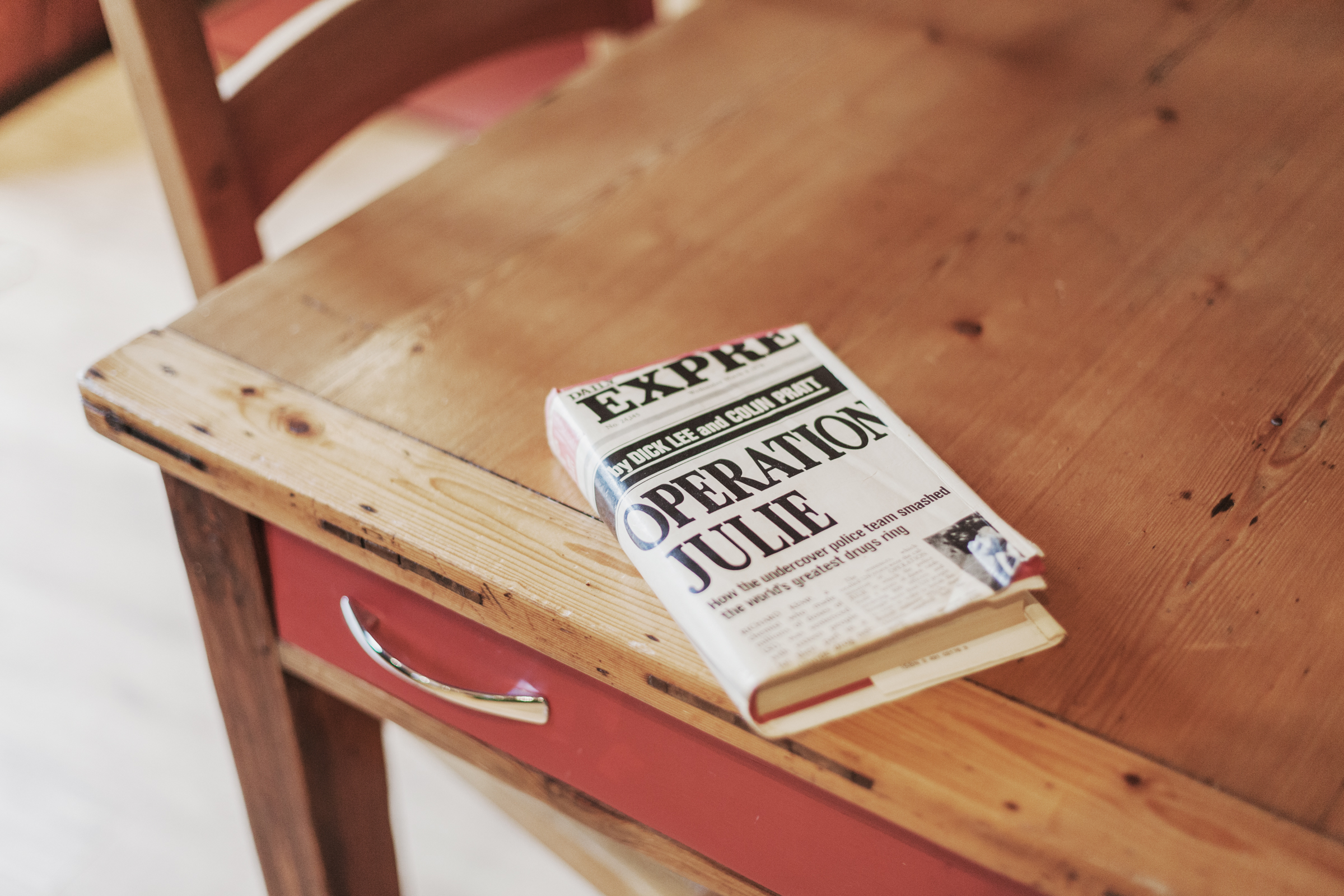
The undercover police operation and subsequent bust (which uncovered 6.5 million tabs of LSD and involved two police officers masquerading as wandering hippies for nearly two years) became known as Operation Julie. It is still the biggest ever counter-LSD operation in the UK, and has been re-told through countless articles, books and a few truly terrible TV adaptations, in which LSD is portrayed as some sort of demonic auto-suicide potion. The contrast of metropolitan gangsterism with rural comfort has always made it an irresistible tale – it was a bit like a really lovely Welsh Breaking Bad.
Now, it was back in the news because one of the (since retired) detectives involved had made new claims that a sizeable stash of the LSD is still buried somewhere in the area, and would still be active. It was enough to have the local Dyfed-Powys police force doing overnight patrols, for fear that would-be smugglers, dealers or just naive journalists might embark on an easter egg hunt to unearth some vintage microdots.
So, I finished telling this whole story to the photographer in the pub, and he looked at me and said, “We should go there,” and I said, “Nah.” The story had been told and I didn’t feel like wandering through a village with a shovel in the rain, looking for buried old rumours. And then the photographer said, “No, we have to go.”
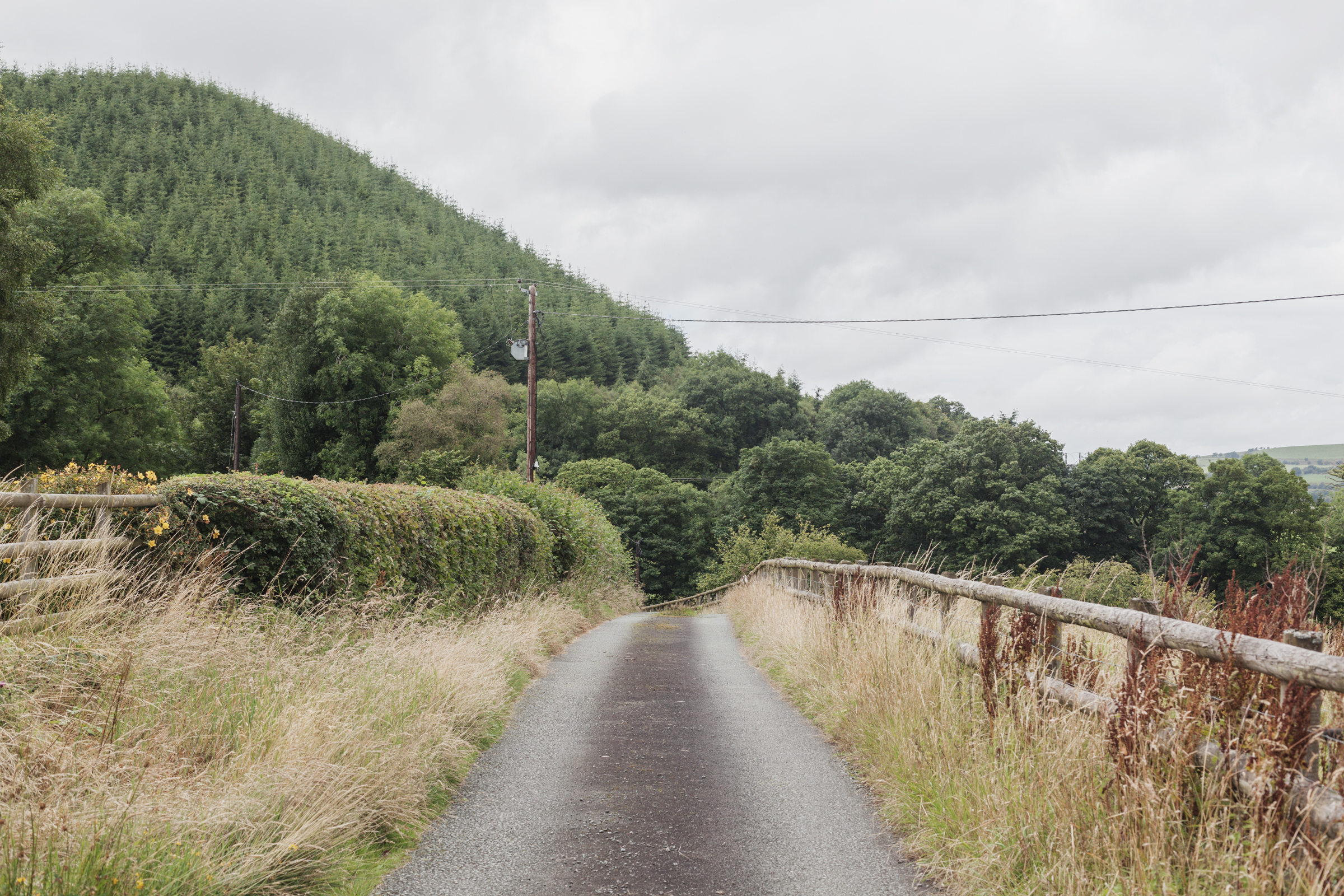
Gay Talese once said, “The story never dies. There is always another story you can write 20, 40 years later about the same story.”
And now here we are, driving down a road that is not an A-road or a B-road, but a don’t-even-try-to-classify-me-road, peering anxiously at red flags and signs that say “BEWARE: MILITARY FIRING RANGE”, and beeping the horn at road-dwelling sheep who respond by having panic attacks and running face-first into the front bumper of the photographer’s red VW Polo.
The GPS says we are 15 miles from Llanddewi-Brefi; the timer says those 15 miles will take one hour and ten minutes. “Ha! Those are Welsh miles,” a lolling villager with sad eyes will tell me later in the pub.
THE GREEN DESERT
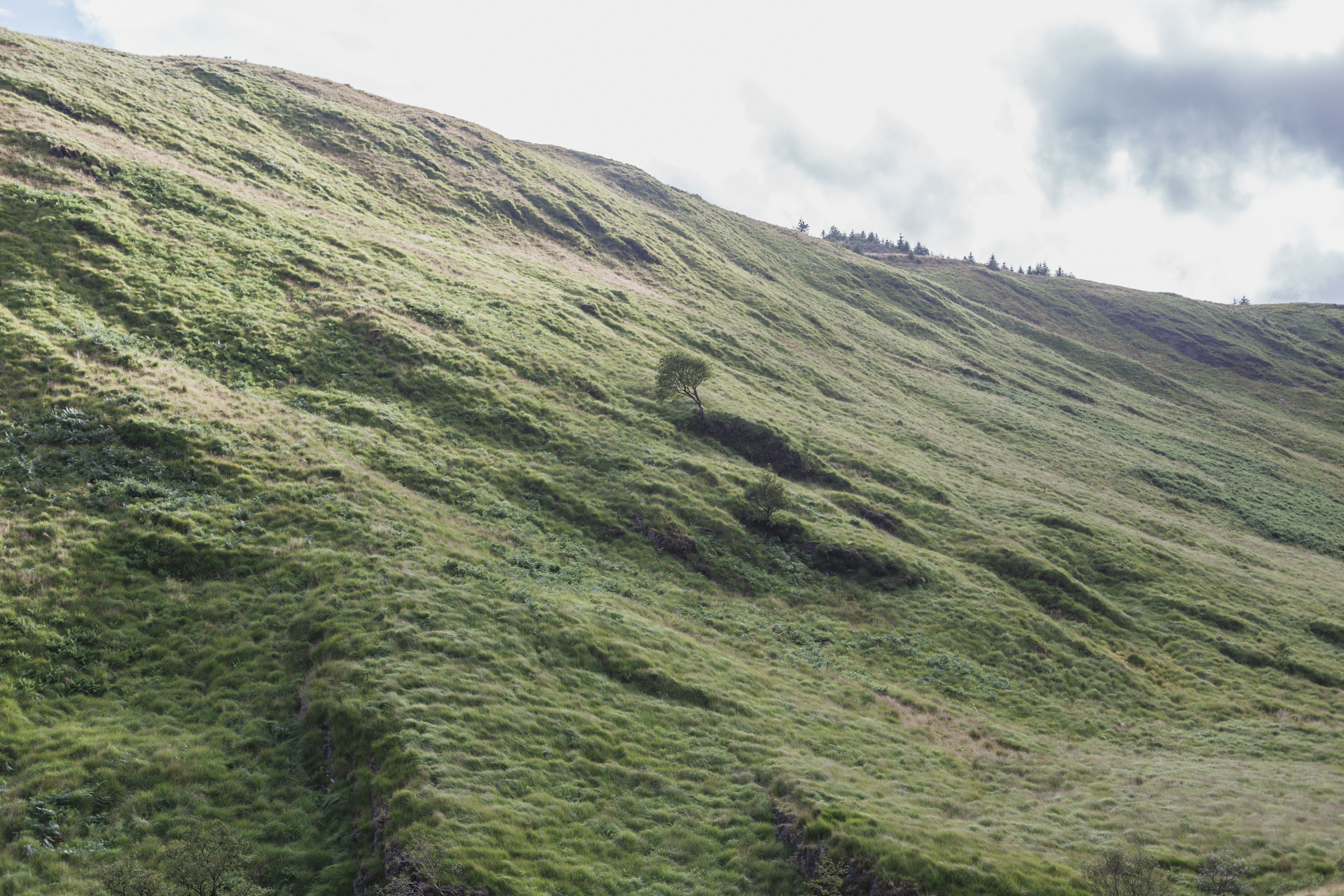
What isn’t North Wales or South Wales or East Wales or West Wales is known as mid-Wales. And in the middle of mid-Wales – straddling the counties of Powys, Ceredigion, and Carmarthenshire – is a place described in Welsh folklore as the Green Desert, thanks to its lack of proper roads or civilisation and its abundance of lush blue-green mountains, sloping valleys and ancient streams. I read on an astronomy website that if you look up here on a clear night, the naked eye will see the entire Milky Way stretching out across the black sky. And for some reason, this specific part of Wales has often cast a strange spell on people, luring them for various inexplicable reasons.
“You are as far away / As you will ever be from the world’s madness,” wrote Welsh nationalist poet Harri Webb – who was responsible for the popularisation of “green desert” – of this area in 1969. The LSD dealers must have agreed. As did Salman Rushdie, who deemed the area a suitable place to go into hiding in the 80s after the Ayatollah of Iran put a fatwa on his head. Numerous hippy free festival organisers also felt drawn in the 70s, bringing their thousand-strong parties primarily for the remoteness, but also for the liberty cap magic mushrooms that still grow rampantly throughout the valley.
The drive through the desert is a sublime and winding trail that goes up and then down and then up and then down seemingly forever. A dense forest of sitka spruce drapes seductively over the shoulders of the valley, and patches of yellowing within the fluffy greens turn golden and velour in the sunshine. At the foot there is a gushing stream that starts life up mountain as a waterfall, and it all looks a lot like a really great whisky advert.
For someone who’s just travelled from loud and stinking London, there’s an exultant strangeness out there, beyond the car window. It’s like the countryside is flexed; alive and breathing – and I can’t help but feel struck by an irrational and eerie sense that it knows we’re driving on it.
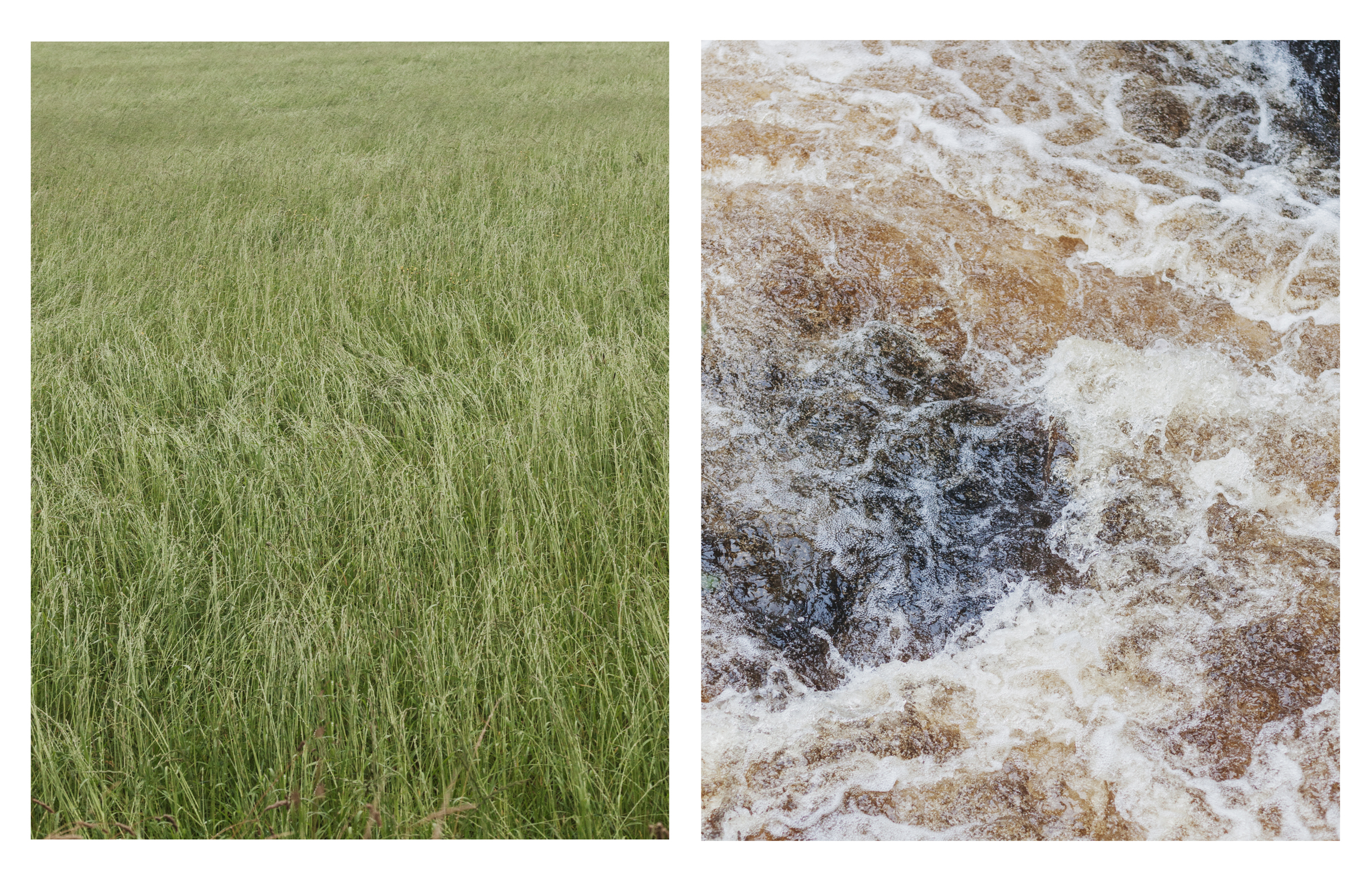
We pass a ghostly and abandoned presbyterian chapel deep in the wilderness called Soar Y Mynydd. Former US president Jimmy Carter used to come here for fishing holidays. Carter could fish anywhere in the world, but something about the green desert kept drawing him back. He bought a landscape painting of Soar-y-Mynydd for his art collection. “I’ve never seen anything like it in my life,” he said.
The car sputters and chokes up a 40-degree incline (which, according to the GPS, is called the Devil’s Staircase) and swings round a hairpin to reveal yet another 400 yards of satanic climbing. These windswept zig-zag roads were never meant for VW Polos; they were routes used in the Middle Ages by the drovers, a mysterious and charismatic breed of Welshmen who made a living going around farms and collecting cattle for export, which they would then march to the markets of Birmingham, Manchester and London. Some drovers even marched geese, putting little leather booties on their feet so they didn’t wear away.
Later, drug smugglers would use the same routes to drove herds of LSD to some very different markets in England.
Right in the heart of this vast and undulating desert, perched on the side of a great big mountain, sits a village of no more than 500 people: Llanddewi-Brefi – a village that looks pretty much like every other village in Britain, and yet, when you dig beneath the surface, you notice the strangest quirks and peculiarities that begin to explain its mysterious magnetism.
THE KILLER IN THE HILLS
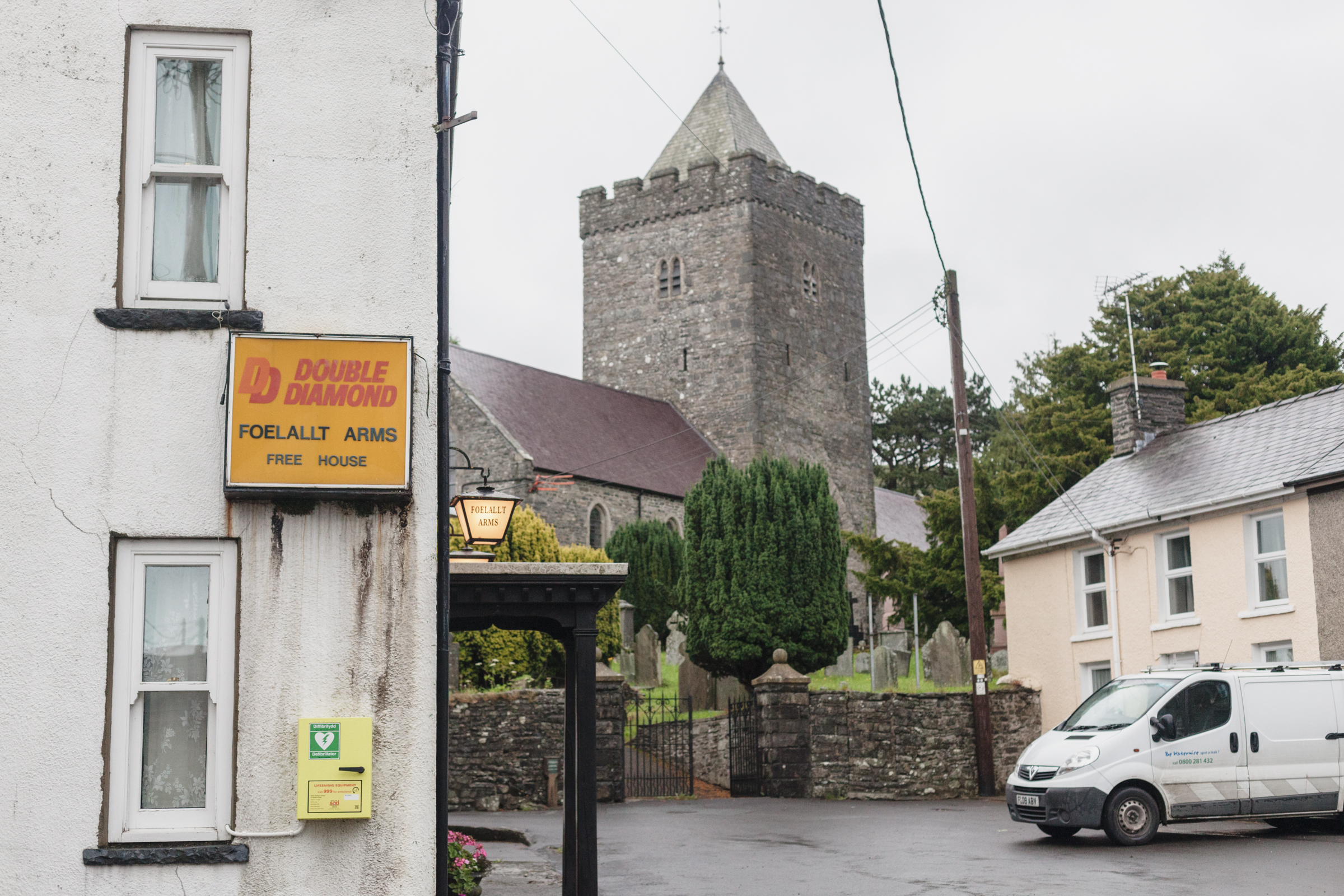 Llanddewi-Brefi
Llanddewi-Brefi
We arrive at 6.13PM on a Thursday evening. There is a silent deadness in the air, which is only enhanced by the way an incoming night sky has combined with some Turner painting rain clouds above to drench the village in a deep blue grey. The street is deserted, except for a lady in the graveyard tending to some flowers at a headstone.
Except for a few narrow lanes that spiral off it, this is a one road village, and all of the cottages, the pub, the village hall and the shop are built around it. It seems like the type of place where if your milk wasn’t taken in by 10AM, someone would knock to check if you were OK.
In the east, St David’s church has a god’s eye view, towering above every home. It’s perched upon a remarkably artificial-looking hump of earth. The story goes that St David, the patron saint of Wales, came here to preach around the year 560. As he began to address a large crowd of villagers, some complained that they couldn’t see or hear him, and so he summoned the flat ground to rise into a mound so he could be seen and heard. The church was built thereafter, and Llanddewi-Brefi (which translates roughly as Church of David on the River Brefi) earned its name.
Until the 2000s, the church was the village’s main tourist attraction. Then, in 2003, Matt Lucas and David Walliams used Llanddewi-Brefi in Little Britain as the home of Dafydd, AKA “The Only Gay in the Village”. They’ve never really explained why. People still arrive during the summer months to take photos next to the village sign. And on four separate occasions, it’s gone missing and re-appeared on eBay, much to the dismay of the local policeman. “I reckon about 99 percent of the village hasn’t seen the show,” said a local when the BBC and the rest of the mainstream media flocked here for vox-pops in 2004, “the rest find it funny.”
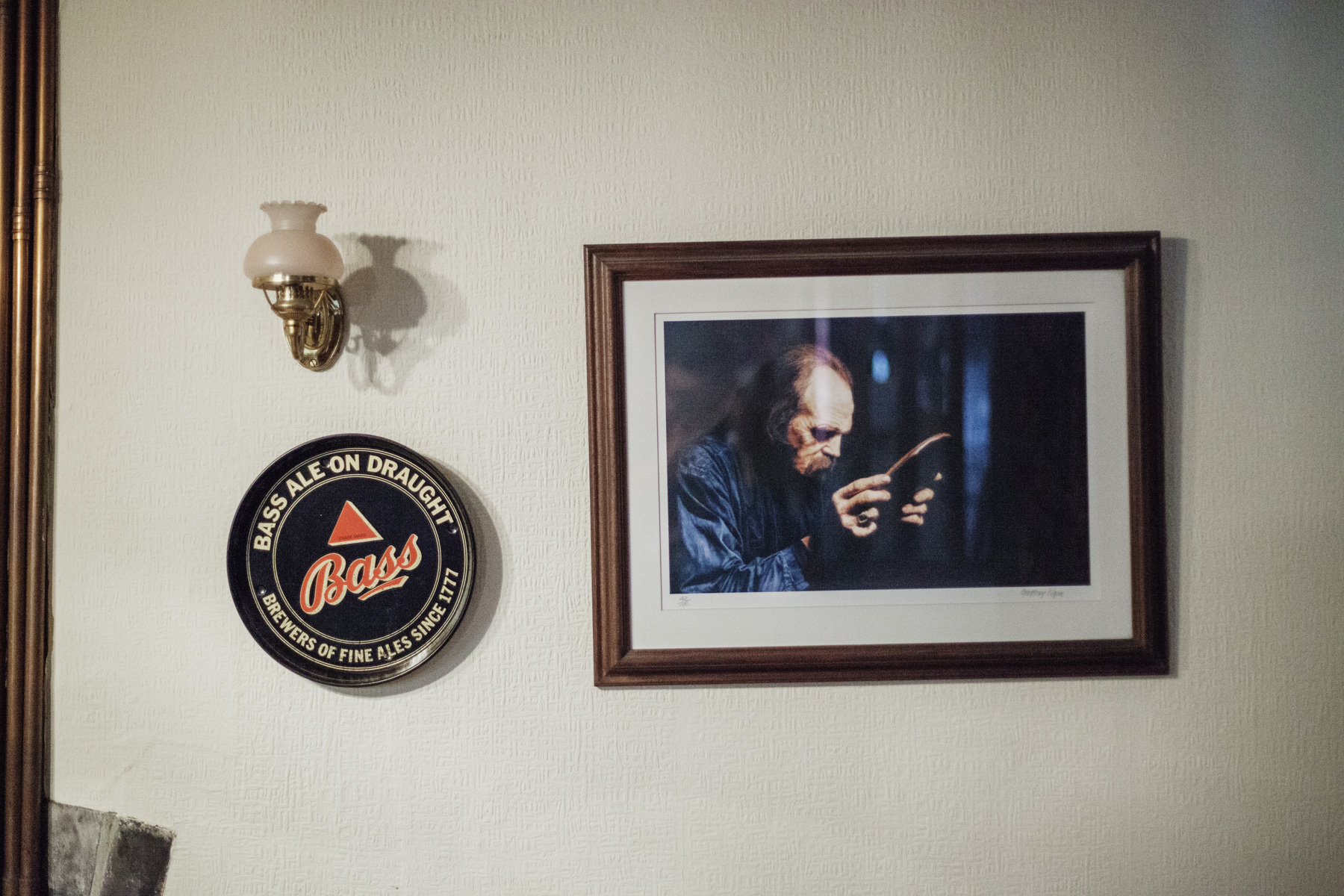
The wall of The New Inn
We get to the entrance of the village pub, The New Inn. This is where all the action took place during Llanddewi-Brefi’s acid years. On a busy night, the pub would be a mixture of locals, an LSD dealer called Smiles and his friends and associates, and the two undercover policeman, each of them either unaware of or hiding their true selves from the other, yet raucously getting pissed and playing darts together. Afterwards, they would all pile back to Smiles’ cottage for a few joints, a line of coke and perhaps even a trip.
Just as we’re about to open the door of the pub, a very pissed man comes tumbling out singing “Feeling Good” by Nina Simone. He looks embarrassed, so I tell him he has a good singing voice, and he shakes his head. “What are you two doing here anyway?” I forget subtlety exists and tell him we’re journalists from London, here to dig up some old LSD.
“Well…” he starts, “my mother moved here in 1972, and she did some babysitting for the LSD chemist and his wife. She phoned me one night and said, ‘John, it’s ever so strange. They have no furniture and strange pictures of–.'” He immediately hushes his voice as an old lady shuffles down the street beside us. We watch her pass, then turn back to face John, who has now bolted across the street and out of sight.
We walk into the New Inn to the predictable “Who’s this then?” silence, pierced only by the squeaking of old necks turning. Then everyone turns back to their pints and the ambient opera of pub chatter resumes, some in English, most in Welsh. It has the feeling of someone’s front room: everyone sits at the bar, nobody sits at the tables, but there’s no more room at the bar so we sit at the tables. It immediately ostracises us.
There’s a man on a stool wearing a hi-vis jacket, whose entire face is covered in dirt, just two little white eyes poking out. He finishes his pint and leaves. “He’s always mucky, but I never see him work,” someone says, “I think he must put the dirt on his face before he comes in.”
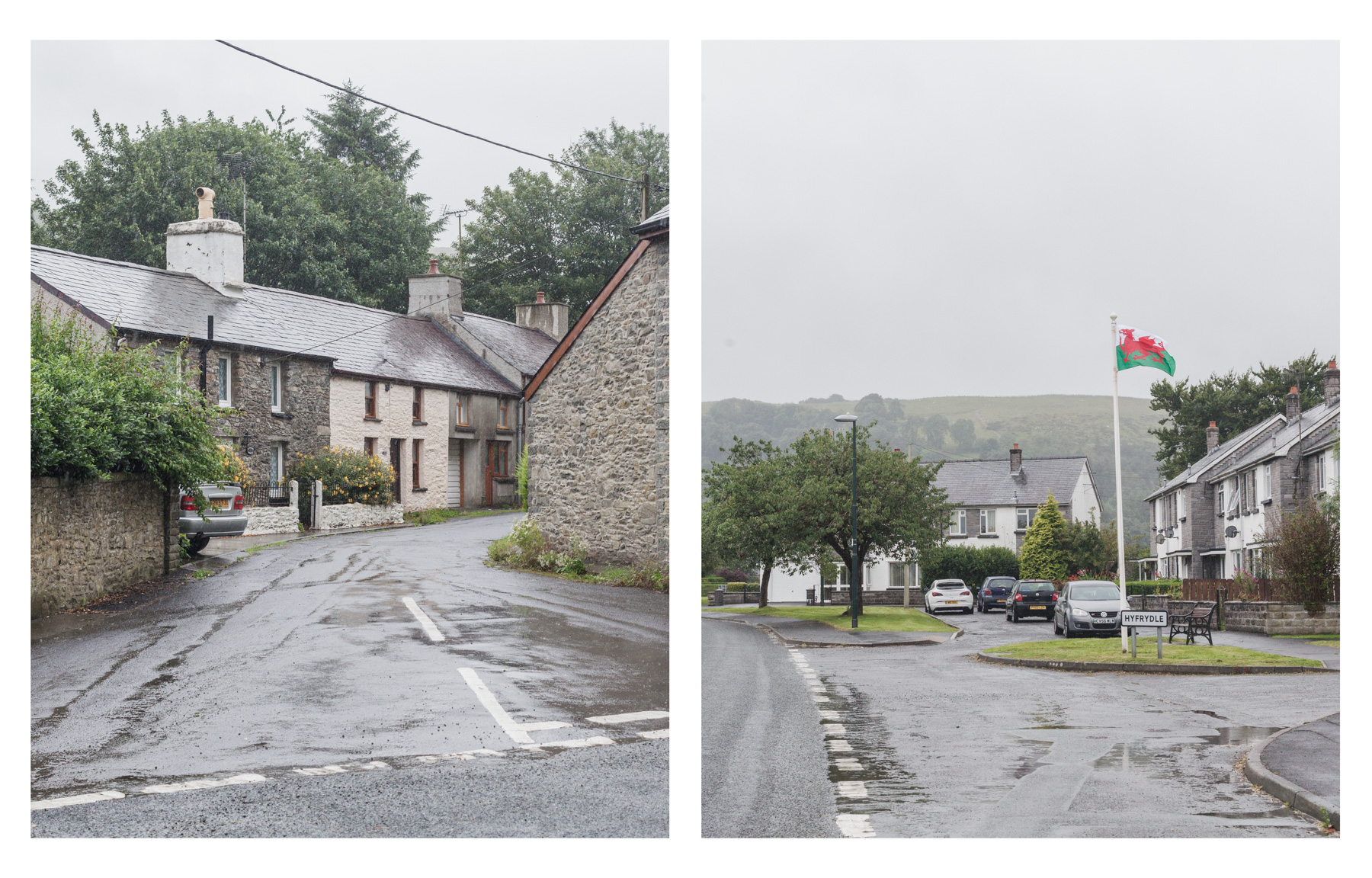
You can imagine how integral the existence of this pub must have been to the police bust. If it didn’t exist, I can’t picture how anyone would ever meet anyone around here, bar chance happenings at the postbox. Just as it is all over Britain, what’s left of traditional village life revolves precariously around the school, the church and the pub. But with rural schools like Llanddewi-Brefi’s ever under threat of closure, and churches increasingly under-attended, the onus has often fallen on the latter. That’s not to say the New Inn is bustling; it’s half empty, and I’m told it was half empty back in the 70s too. But in communities of this size there is literally nowhere else for people to simply be in each other’s company.
The walls are dotted with pictures of the local football team, paintings by a local artist called Geoff, photos of how the village used to look and notices for upcoming events. It isn’t just a pub; it’s a museum of village life. Before it was a pub, it was an inn for the drovers, with a stable over the road and field out back where they could park their cattle.
Already feeling like an outsider, I start easy by talking to a man with a Cockney accent, who looks to be in his fifties. He tells me he moved here when he felt London was getting too dodgy. He’d been sitting in a Harvester in Romford one day, eating his Sunday lunch, when a group walked in, sat on the table next to him and began “effing and blinding” about how they were going to stab someone. “That was enough,” he says. “We came here. Clean air, no crime rate. It’s like living in Romford 50 years ago.” He now owns the village shop.
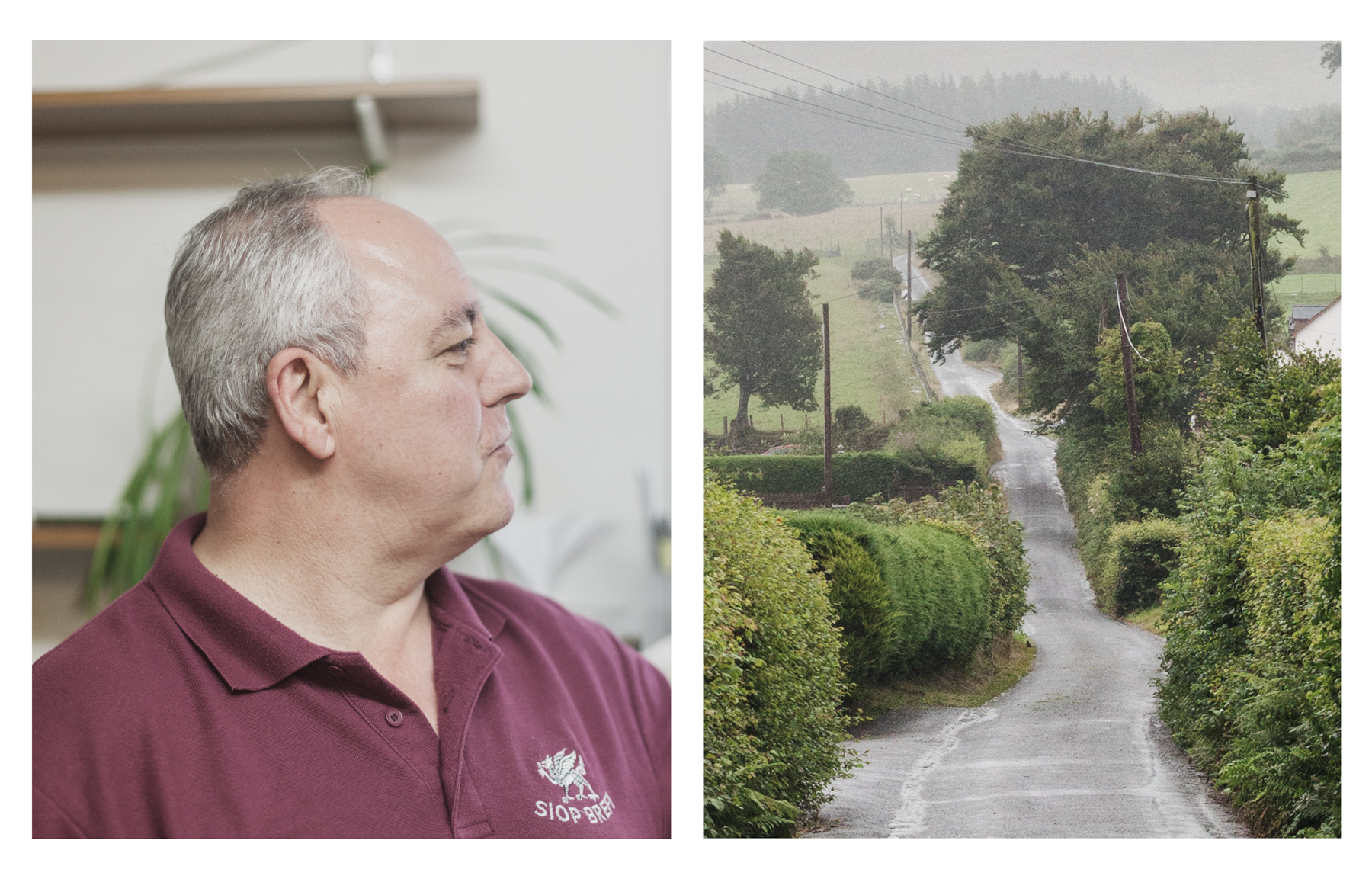 The shopkeeper
The shopkeeperElaine is at the bar sipping a fizzy drink through a black straw. I don’t know what it is, because it was ordered as “the usual”. She was born in the village and used to be a teacher at the school, but has now retired. Her grandad was a blacksmith, and in her spare time she likes to go from village to village trying to find wrought iron gates and fences with his signature markings on them. It’s her way of getting to know him.
When I tell her I’ve come from London, she says, “Somebody has to.” And when I get the dictaphone out to record her, everyone looks at it like I’ve put a grenade on the bar and pulled the pin. As we talk, a man with a red puffy face behind her drinks Strongbow and stares at me intently. “Not everyone likes it when people talk about Operation Julie,” she says.
Elaine was a teenager during the acid days, and remembers them vividly. “We were quite naive, really. I suppose, looking back, it should have stood out: a guy with an English accent, velvet jacket and bell bottom trousers with a name like ‘Smiles’. They didn’t hide themselves either. Smiles would often be in the pub, lighting his cigarettes with £20 notes. One time he got talking to a man from the village who told him he didn’t have a TV. The next day he went and bought him one. But Llanddewi-Brefi was a melting pot back then, so we didn’t question it.”
I tell her I’m developing a theory that while most villages have one big story, this particular village seems to attract strange happenings at an abnormal rate. “Well, the 80s was a difficult time here…” she begins. “It was January, 1983. Someone had come into the house and said to my mother: ‘Well, I’ve just seen something I’ve never seen before, someone walking across the mountain in the dead of night…'”
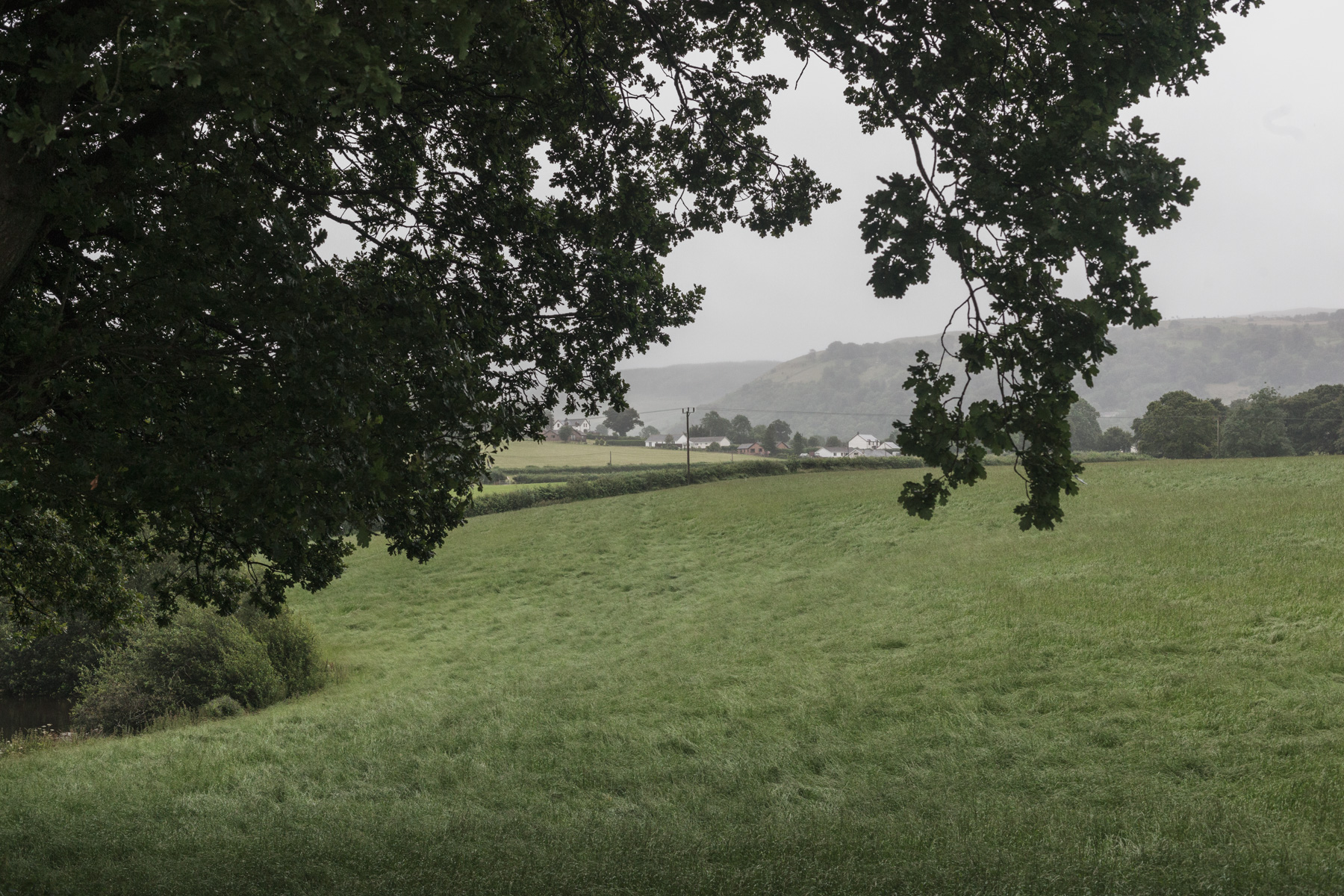
The figure had been walking near Brynambor, a remote sheep farm owned by John Williams. The next day, some nearby farmers went to check on John after being told he’d failed to answer his door. They found him in the bedroom. He’d been shot five times with his own gun. The killer was soon discovered to be a 33-year-old English drifter called Anthony Gambrell, who was now on the loose and thought to be hiding in the hills. It sent shockwaves through the village. John Williams was well-loved; the treasurer of Soar-y-Mynydd chapel, he had been described as “the happiest man in Wales”.
The killer in the hills had been terrorising the village for years. Nobody knows why he first came, but he’d developed something of an obsession with Llanddewi-Brefi. He found occasional shepherding work and was known to sometimes sleep rough up the mountain. Six years before the murder, he’d broken into John Williams’ home and stolen a gun. Later, he’d taken an elderly couple hostage with a sickle. For centuries, British folklore warned petrified children of symbolic black dogs; evil and malevolent forces in the hills that strike fear into small communities. Now, Llanddewi-Brefi was living a nightmare made real.
The police feared he would could kill again, or at least take hostages. Villagers were told to lock their doors, check on their neighbours regularly and not to go out at night. They were given a secret code to use if in danger, and police called remote farms every half hour to check on them. The fear was too much for many, and 12 farmers moved away during the hunt.
The police eventually traced Gambrell: he’d fled to Hampshire. He was tried and sentenced to 30 years in prison at Lampeter court, nine miles from Llanddewi-Brefi. A crowd of villagers gathered outside the court to express their anger at him as he was bundled into a van. Last year a Welsh documentary series called Y Detectif revisited the murder. It discovered that Gambrell still sends letters to some of the residents of the village from his prison cell in Durham.
“We’ve never recovered the gun, which is a worry,” says former detective John Lewis during an interview in the documentary. “When he’s released, he might return to the gun. Who knows if he’ll come back?”
A SACRED MONSTER
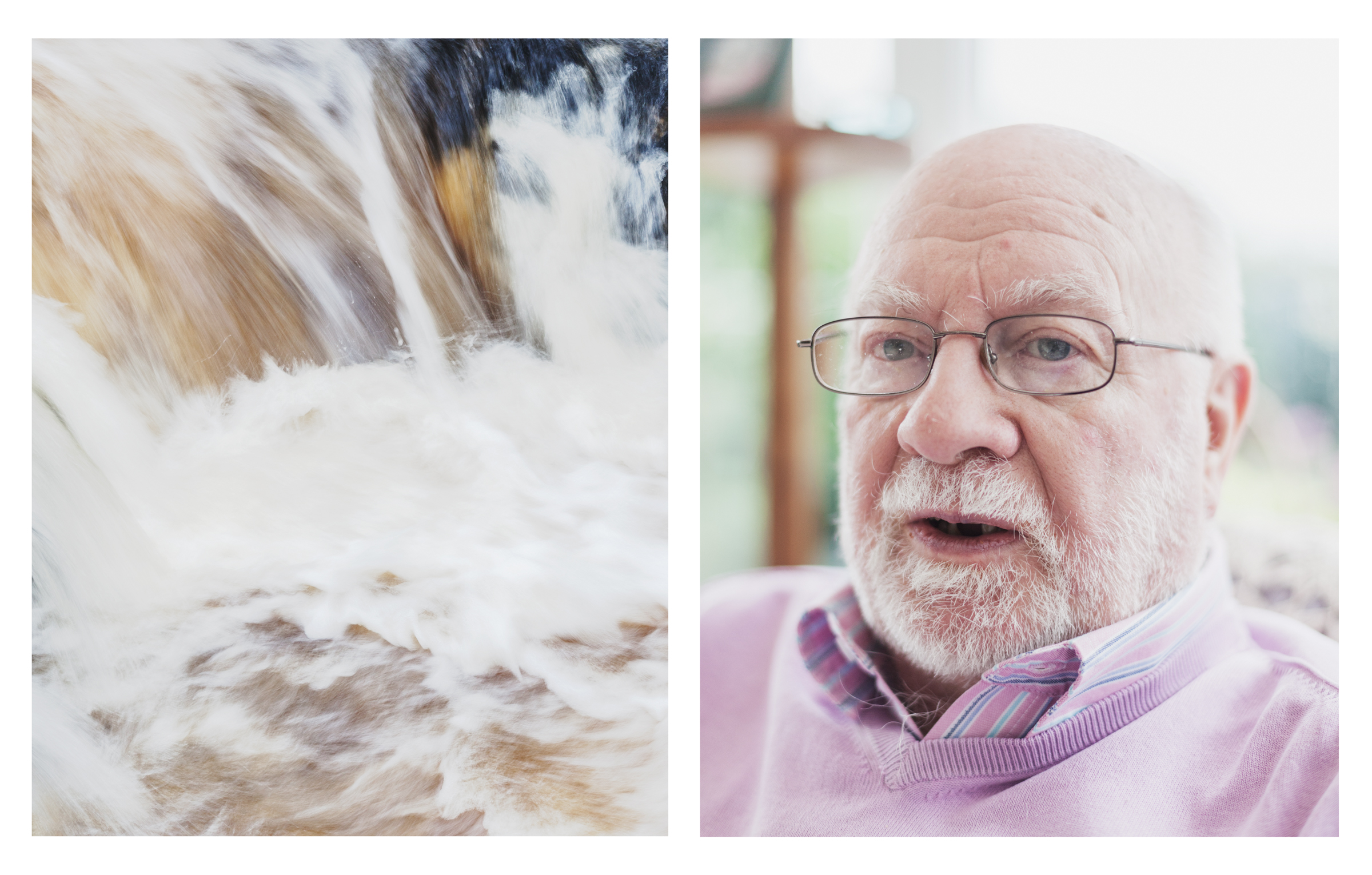
Mr Ebenezer is sitting on the sofa in his conservatory, wearing a purple cotton jumper and beige trousers, peering through his rounded rectangular spectacles at the Cambrian News while Sky News blares in the background. He has a Daily Mail next to him too, which he buys every day so he can “stay aware of what the enemy is up to”. He speaks with a theatrical and earthy mid-Wales accent – it has a soft lilt and sing-song feel that makes you want to tap a beat out on your knees.
Through the conservatory door is the dining room, where Mr Ebenezer’s silver laptop sits closed, but ready at any point to be opened. Since 1967 he’s been a journalist and celebrated local author. Forty years ago, at around 11AM on a cold March morning, he was one of the first reporters on the scene to the bust of Operation Julie, wandering through the village as neighbours stood on the doorsteps observing the chaos, declaring they knew something was up all along.
“They didn’t know a bloody thing!” laughs Mr Ebenezer. It became the biggest story of his career, and he wrote a book about it, titled Operation Julie: The World’s Greatest LSD Bust. He tells me nobody has a bad word to say about the LSD guys around here: Smiles, especially, was bit of a local hero.
“I remember thinking about the story of how St David made the ground here rise from beneath his feet,” says Mr Ebenezer, “and thinking: those people making and taking all that LSD have probably seen things like that happening. Nothing’s changed round here at all!”
When I ask him if he thinks there might be some acid buried somewhere in the village he grins mischievously. “Oh, they love that talk in the village. They keep it going. I do think there must be stuff left, though, no doubt. Some say it might be buried in the quarry, but I think Smiles is behind that rumour. He was a very naughty boy.”
I ask Mr Ebenezer whether he knew of any other strange happenings in Llanddewi-Brefi, and his eyes light up as he begins talking about a mysterious man who appeared towards the end of the 60s, a decade before the LSD. “He was an amazing man. Bloody mad, but highly intelligent. A fugitive from The Krays apparently, and he had a scar from ear to ear.”
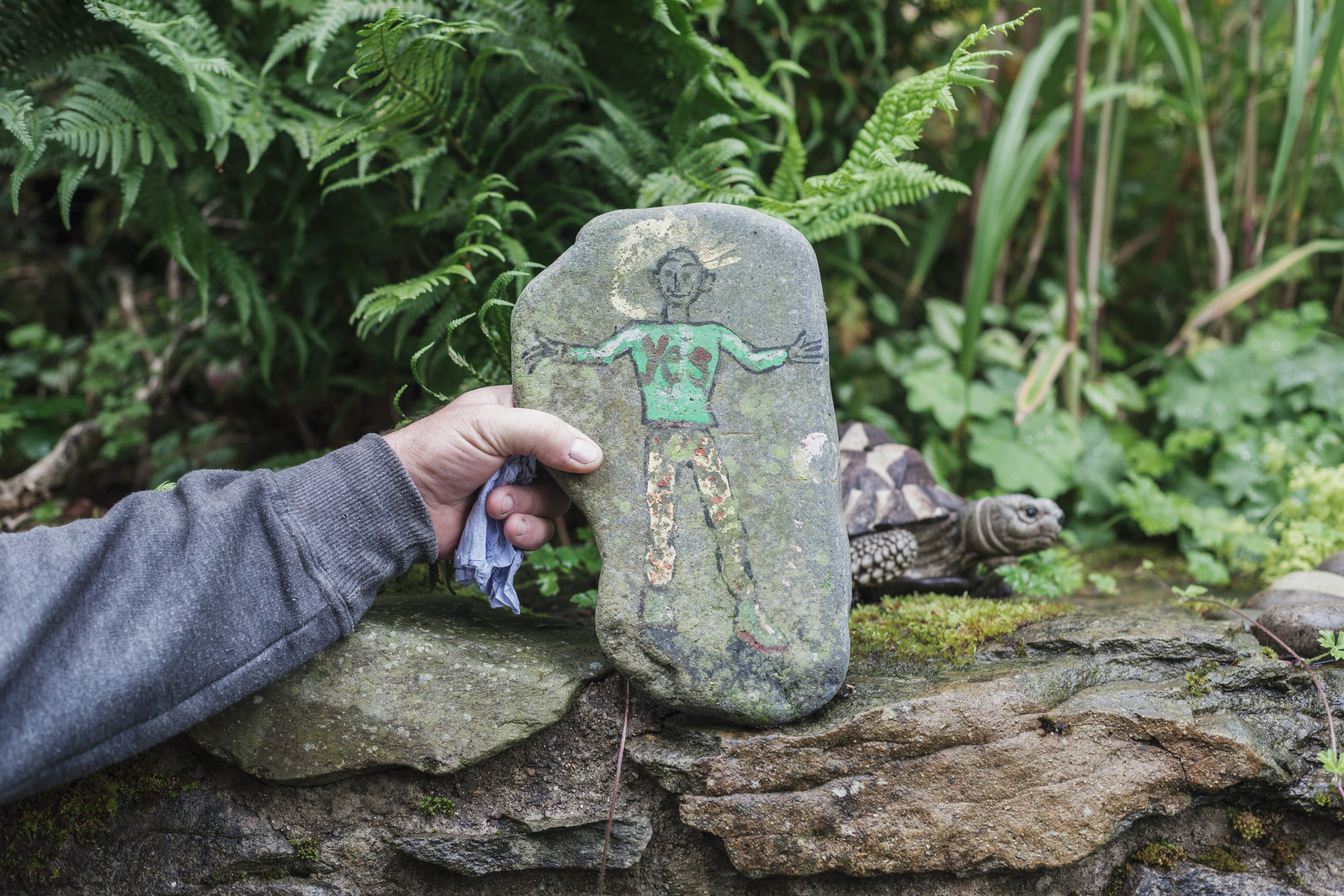
The man in question was David Litvinoff, an enigmatic and mercurial character in 50s and 60s London with as many connections to the worlds of rock and roll and fine art as he had to the aristocracy and the criminal underworld of The Krays.
The English jazz and blues singer George Melly described Litvinoff as such: “The fastest talker I ever met, full of outrageous stories, at least half of which turned out to be true, a dandy of squalor, a face either beautiful or ugly, I could never decide which, but certainly 100 percent Jewish, a self-propelled catalyst who didn’t mind getting hurt as long as he made something happen, a sacred monster, first class.”
One night in 1968, Litvinoff had a disagreement with one of his gangster associates and was badly beaten up. Shortly after that he vanished. When he re-appeared some months later it was in the Llanddewi-Brefi village shop, begging the shopkeeper to let him take some provisions on spec because he hadn’t sorted himself any cash yet. He had moved into a small whitewashed cottage with a slate roof on the edge of the village, called Cefn Bedd (which translates as Behind the Grave).
Soon, Litvinoff’s famous friends were arriving from London to visit him in this little village that he called his “Celticlimboland”, where “nothing is the norm and quite rightly so”. Between the years of 1970-72, The Rolling Stones, Eric Clapton, Marc Bolan, John Lennon, Yoko Ono and many more all made their way to Llanddewi-Brefi, much to the amusement and confusion of the locals. One time Litvinoff rounded up a group of excited older women in the post office after telling them he had Cliff Richard in the car outside, only for them to shrug with disappointment when it was actually a bewildered Keith Richards.
Notorious parties would take place at his home, a mixture of London friends and any young locals who were brave enough. “On sunny days,” writes Keiron Pim in his biography of Litvinoff, Jumpin’ Jack Flash, “he would hoist his stereo’s speakers up into the branches of the trees by the cottage and blast music out across the fields while he and his friends went skinny-dipping in the river or lounged naked on sofas in the meadow, smoking hash.”
When Mr Ebenezer visited Litvinoff at his cottage one afternoon, he noticed an invitation on the side to Jimi Hendrix’s funeral in Seattle. There was a boiled sweet attached to it: the message inside said the sweet was laced with LSD and instructed anyone who couldn’t attend the funeral to take it on the same day. In a series of events that led to Litvinoff leaving the village for good, he offered the sweet to a local policeman who was doing the rounds one afternoon. He spent the rest of the day splayed across Litvinoff’s sofa, hallucinating and shouting nonsense down his walkie talkie.
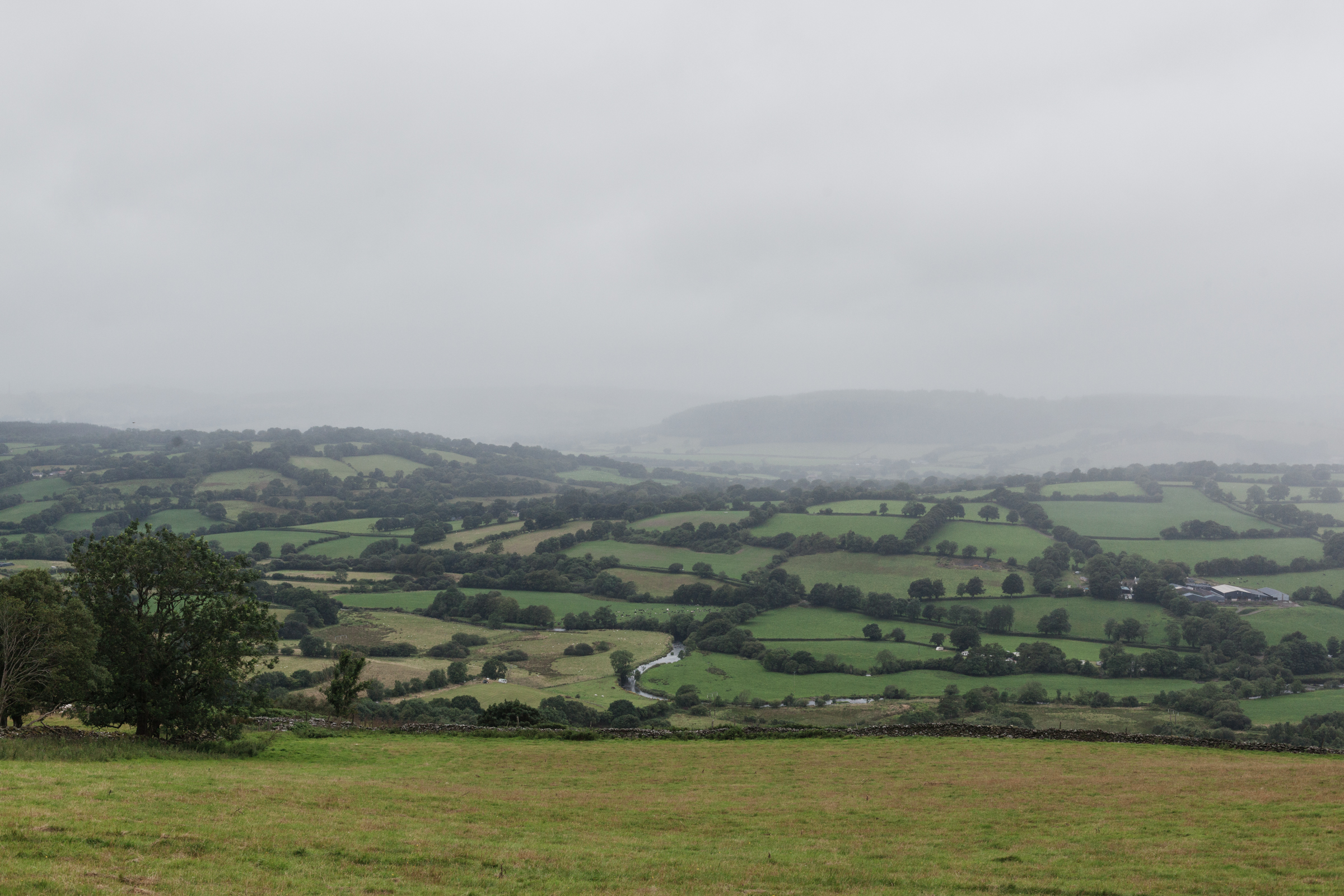
In the 60s and 70s, there was this growing notion of the rural idyll as an escape from a world that seemed to be spiralling repeatedly into war and chaos. Many had nostalgic conceptions of the countryside as a place straight from 16th century Dutch landscape paintings; where life is changeless and lived at a slow pace. There was a particularly English fantasy of the countryside as a more authentic, civilised and fulfilling world than the dirty, fast-moving and industrial reality of city life. It’s something that is returning again now, as people recoil from the hyper-connectedness of metropolitan existence and potential nuclear war, and start to dream again of absolute isolation via AirBnB river boats and huts in the mountains.
But, as observed by the sociologist Howard Newby, those Dutch landscape paintings were never portrayals of rural reality: they were utopian dreams of pastoral beauty created in adherence to a set of rules about what made a painting picturesque. And when Litvinoff – and many of the hippies and good lifers that would follow him – moved out to places like Llanddewi-Brefi, they often found that life was not perfect and simple, and that the countryside was an unrelenting place that came with its own unique demons.
“Litvinoff was too gregarious and urban,” explains Keiron Pim. “Whenever he visited London having been in Wales, he would just talk and talk because he’d been alone and couldn’t deal with the solitude. He was someone that needed people around him. Ultimately, Llanddewi-Brefi drove him mad.”
Litvinoff was taken to court when his dog massacred some sheep. Soon after, he left.
BEING STRAIGHT IS THE CRAZIEST THING YOU CAN DO
Smiles never set out to find Llanddewi-Brefi back in July of 1971, but he did anyway. He, his girlfriend and her daughter had been driving around various villages in Wales looking for For Sale signs. When all hope was lost they chanced upon Llanddewi-Brefi. Y Glyn cottage wasn’t for sale, but it was obvious nobody lived there. The man next door owned it. He asked Smiles for £1,250. Smiles offered £1,000 and they shook hands.
Smiles was one of the first hippies the villagers had seen up close. Others had passed through, but Smiles’ cottage was right on the main street. He frequented the pub often, joined the darts team and strolled around in bell bottoms and beads, with glitter on his face, henna dyed-hair and daubed eye shadow. He had long dark hair and a great big beard. At first, a few of the local lads wanted to kick his head in. Other villagers speculated about what business he was in; most assumed it was either pornography or bank robbery.
But through a mixture of kindness and ridiculousness, he soon charmed a village, who, by this point, had started to develop an eccentric worldview – or at least an increased openness to things happening around them that are not all that normal.
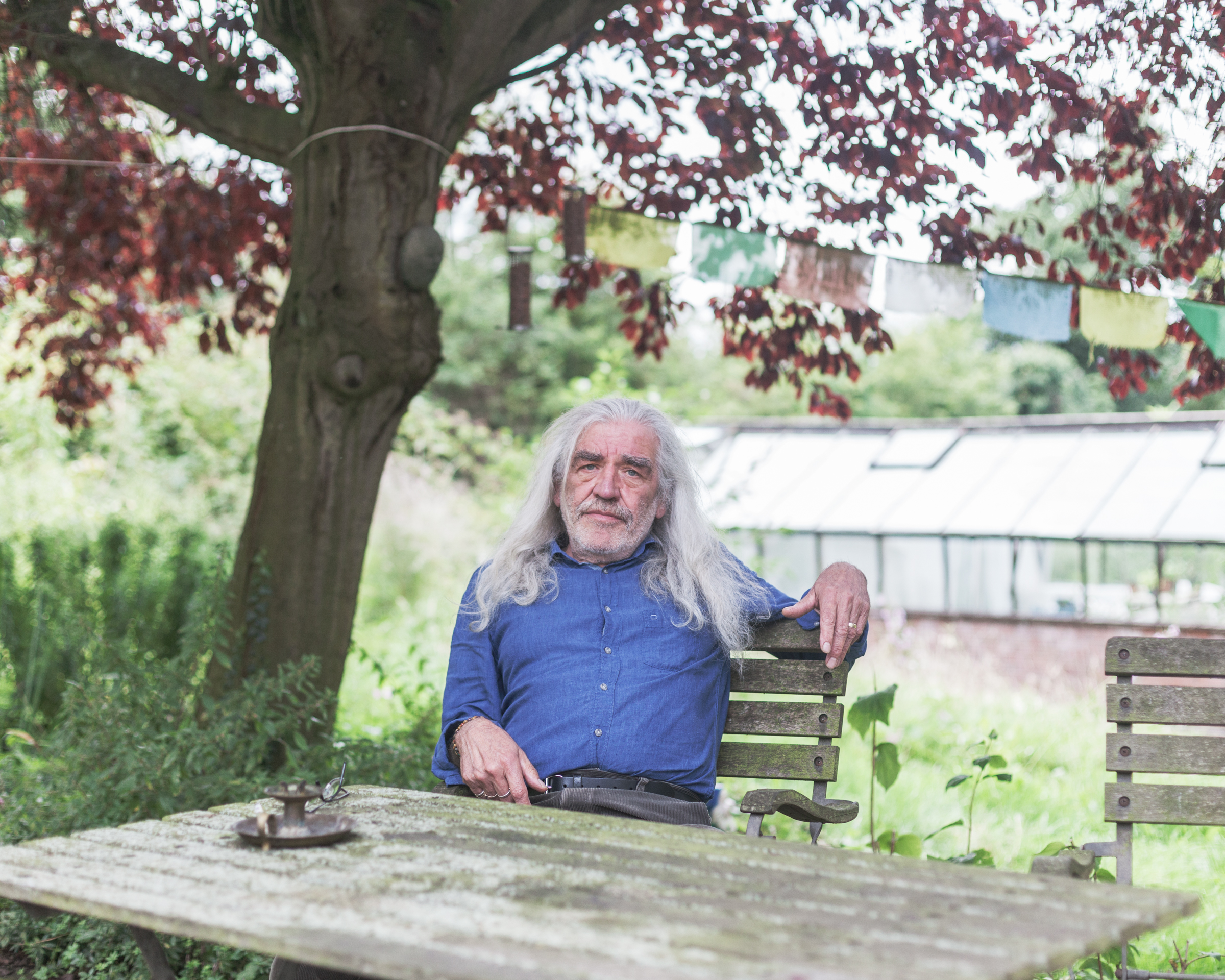
His cottage was a two-up, two-down, and those who had the surreal pleasure of visiting spoke of a huge Parvati (the Hindu goddess of fertility, love and devotion) hand-painted in the living room, and a big blue Shiv Shankar on the back wall. All the skirting boards had been painted to look like grass and snails. In one of the bedrooms upstairs, there was a paper mache of Jimi Hendrix stepping out of the wall, his hair made of copper wire. The kid’s bedroom had been turned into a paper mache cave, coloured light brown with a red and yellow streak, and decorated with reflective baubles. He’d removed the ceilings in both and converted them into a skylight, so they could all fall asleep beneath the stars.
During his time in the village, Smiles would become involved with the LSD network and go from being a reasonably low-level drug dealer to shifting 100,000 thousand tabs of acid per week, making him one of the biggest names in the operation. When the undercover coppers arrived in Llanddewi-Brefi disguised as wandering hippies, Smiles was the target.
Stephen Bentley was one of the undercover detectives. He wrote a book about his experiences, Undercover: Operation Julie – The Inside Story, and is responsible for this summer’s claims that there is still a stash buried. He tells me over Skype that he became tremendously close to Smiles over the two years he spent undercover, and came within an inch of revealing everything to him the weekend before the bust. Smiles swears from the moment he met Bentley he knew he was a copper, but it was a case of keeping your friends close and your enemies closer. Then, at 5AM on the 26th of March, 1977, Smiles awoke to the sound of his door being kicked it, and it was all over.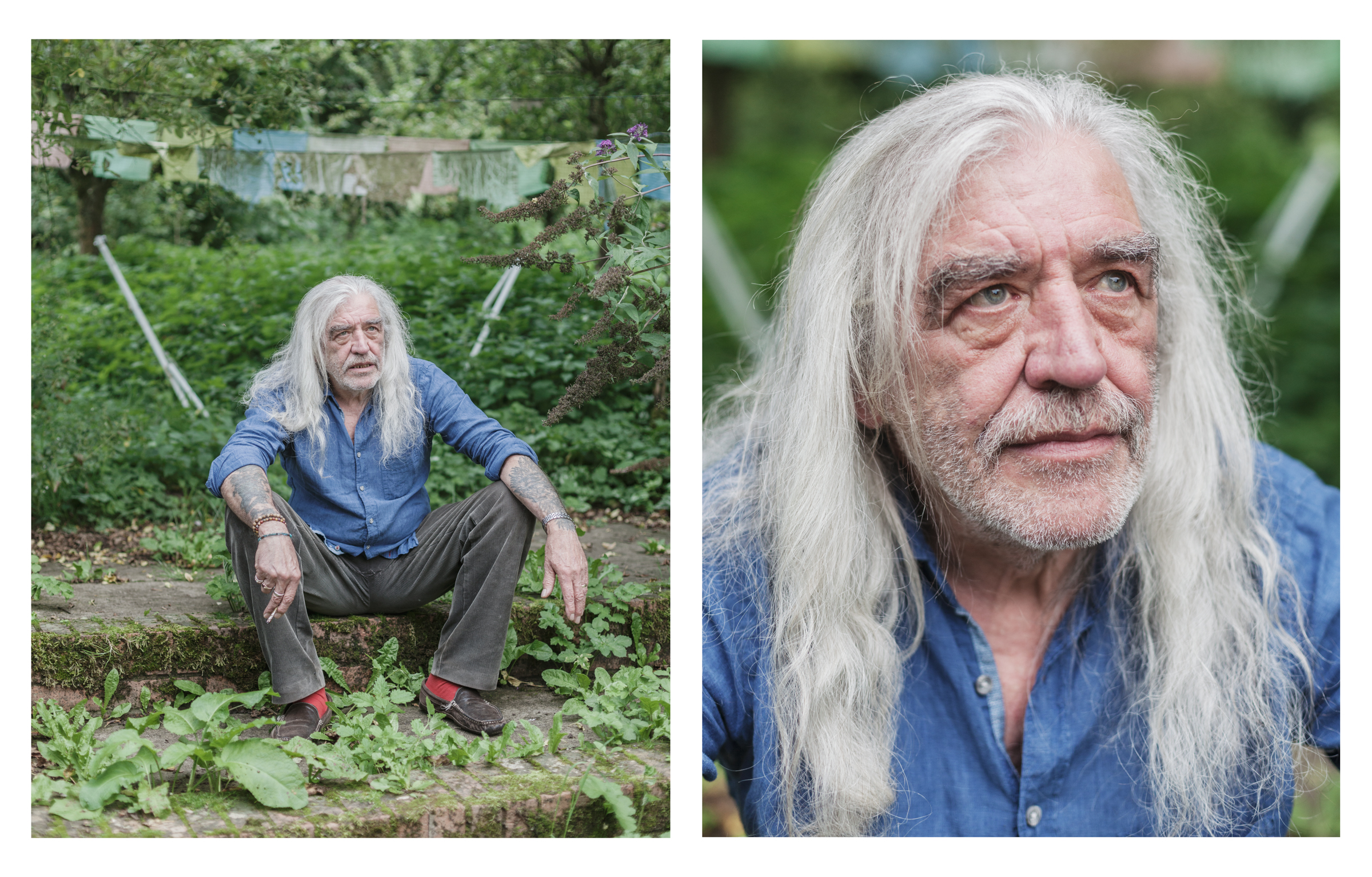
Over the years, Smiles hasn’t featured in any of the books or TV documentaries about Operation Julie, so I assumed he didn’t want to speak about those years any more. But I knew he was still around: I’d heard from a good source that he’d recently appeared at the funeral of one of the other men convicted in the 70s, and that he’d got everyone stoned in the smoking area of the wake. If anyone knew whether there was still some mythical LSD buried in the ground, it would be Smiles.
In the end, finding him wasn’t too hard at all, and after a day of correspondence he invited us round for tea. He’d left Wales and travelled all over the world, but in the end found himself not far from where he started: in the woods near the Welsh border, around two hours from Llanddewi-Brefi. Branches slap the windscreen and long grass that’s grown down the middle of the road strokes the engine as the spunky VW Polo tackles one more alien landscape: the long hidden path to Smiles’ house. It’s obvious nobody’s been up here in a car in quite some time. Finally, we turn a corner and see an old converted farmhouse.
Smiles answers the door to the sound of dogs barking. He has a commanding but kind face; icy blue eyes, a big grinning mouth, a strong nose and a long mane of flowing grey hair down to his shoulders. He’s wearing a tight blue shirt, corduroy trousers, bright red socks and loafers. His sleeves are rolled up to reveal forearms tattooed with dragons and serpents, which I would later find out are covers for old army tattoos. Spiritual-looking jewellery hangs around his neck and he has a fistful of silver rings. He speaks with a subtle Mancunian accent, weathered by years away.
We walk around the back of the house and sit at a summer table next to a pond. There’s old discoloured bunting hanging from apple trees, and the faint sound of wind chimes fills the air. With no through road, his own water supply and a poly tunnel out back growing every type of vegetable, he’s once again found his slice of isolation.
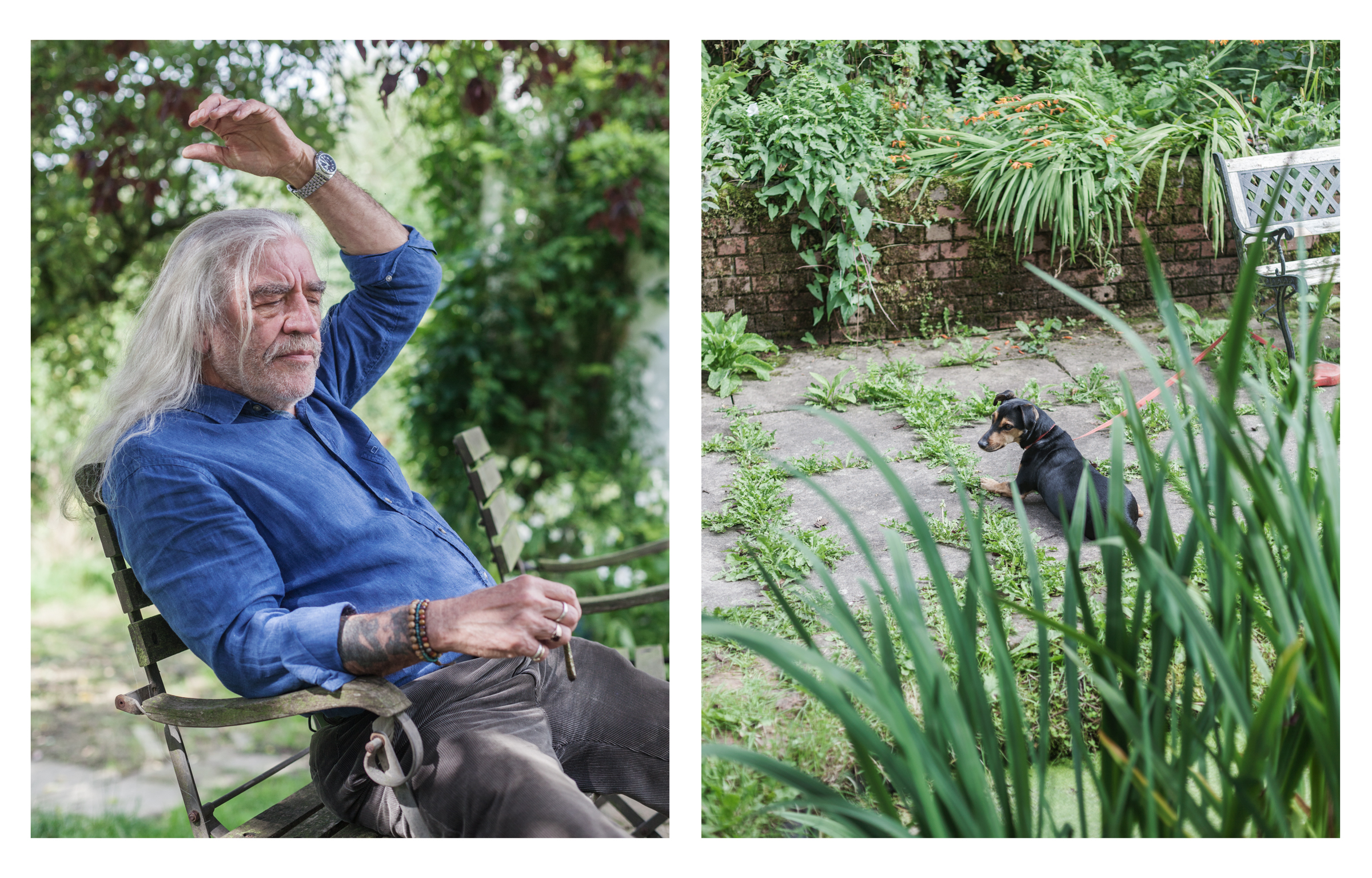
I notice the smaller of the dogs is dragging around an extendable dog lead attached to a rusty old axe head. Smiles catches me staring at it. “It’s not cruel, honest,” he says. “He’s a runner, you see. Last time he was gone for nearly two days and returned starving, cold and mucky in the dead of night. We have to keep him on that when we’re out here.”
My first question is the most obvious one: Why Llanddewi-Brefi? “That’s the question, isn’t it. Why? I’d sure like to know why everything happens there. All I know is we were well drawn.” Second question: What was it like to take possibly the greatest acid ever made? “It blew your head.” Third question: is there any buried? “No, sorry, it’s bollocks.”
At this point, Smiles pulls out a long and meaty green joint rolled in transparent cellulose skin, lights it and takes a series of harsh and experienced tokes. It reminds me of watching a professional tennis player deliver a serve. He offers me the joint. I don’t really smoke, ever, but I figure: when else am I going to be offered weed in the back garden of a former international drug dealer. I take two long and clumsy drags that probably look more like Mr Blobby delivering a tennis serve.
“Llanddewi-Brefi was just another Welsh village, really,” begins Smiles. “There was nothing to mark it out as special, but then it turned out to be very special. You know, I turned the bread man onto acid, the milkman onto acid, even the man that sold me the house. He was a religious fella as well. He was doing alright and then he left the room. Suddenly, I could hear singing coming through the walls. I went round and he was covered in sacks, singing hymns at the top of his voice. Then he decided he was dying, so I held his hand as he died several times. We had some fun, I tell you.”
He carries on talking, but my head starts spinning. I focus intently on not losing my shit, which makes me lose my shit because I’m not listening to what he’s saying any more. I look up. He’s stopped talking. I look down at the questions I’ve written in a notepad. They don’t make sense. I look at the spliff. It looks like a gun in a baby’s hand. I slowly place it back on the table, hoping he doesn’t notice. He does. “That you, is it?” says Smiles, chuckling. From my limited knowledge of weed, I’m going to go out on a limb and say that is some strong shit. His wife walks out with a plate of biscuits. A mixture of shortbread and chocolate digestives. I eat eight.
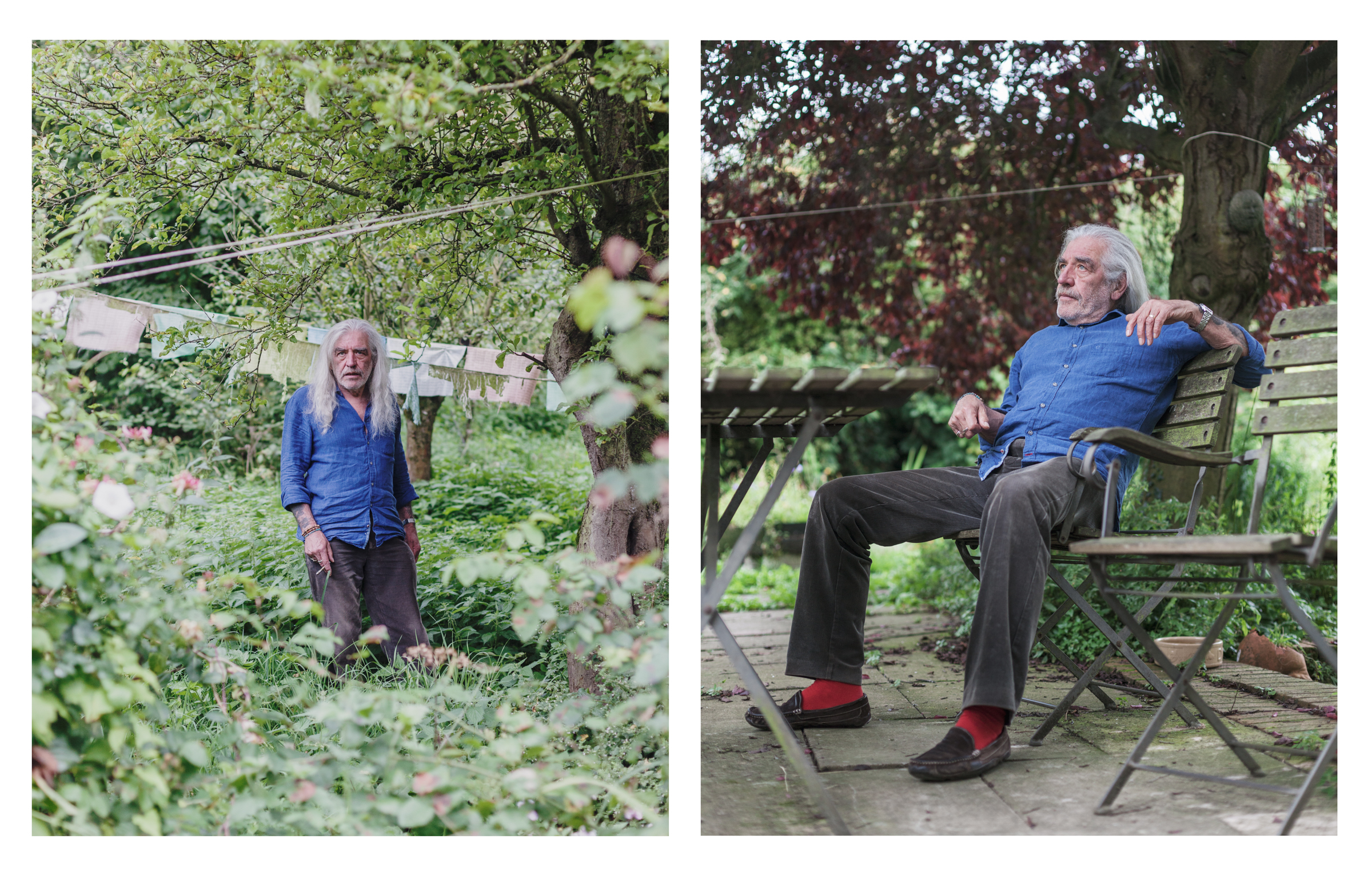
Smiles served five years for his part in the LSD network, but has no regrets. “You have to just live each day as it comes,” he says. “One of the things LSD teaches you is that it’s now. This is now. This is it; the only reality. The money was neither here nor there to me. There was this feeling back then that we were really going to change the world for the better. Acid made you realise that there are greater ways to deal with the problems we face than the ones we use, because look at where we are now.”
At 70 years old, Smiles now talks about UK drug culture as a narrative he’s no longer part of, and he’s quick to assure me he is long retired. But he still monitors it all from a distance. The rise of ecstasy surprised him. To Smiles, it’s a relatively inconsequential and meaningless substance. “It’s amphetamine-derived, isn’t it… so it makes you want to go and stand in a field and dance, but you aren’t really bothering anyone except your immediate neighbours. You aren’t going to change the direction of society and radically alter the way you think; you’re just going to dance and sweat every weekend. I think that has set us back a bit. The world needs another major LSD supplier.”
I tell him it all sounds pretty crazy, this idea that acid can change the world, and he throws his hands into the air and says: “Being straight is the craziest thing you can do, kid. Look at all the crap we do when we are straight. All the time, every fucking day, just keep peddling!”
ZOOM ZOOM ZOOM, BOOM BOOM BOOM
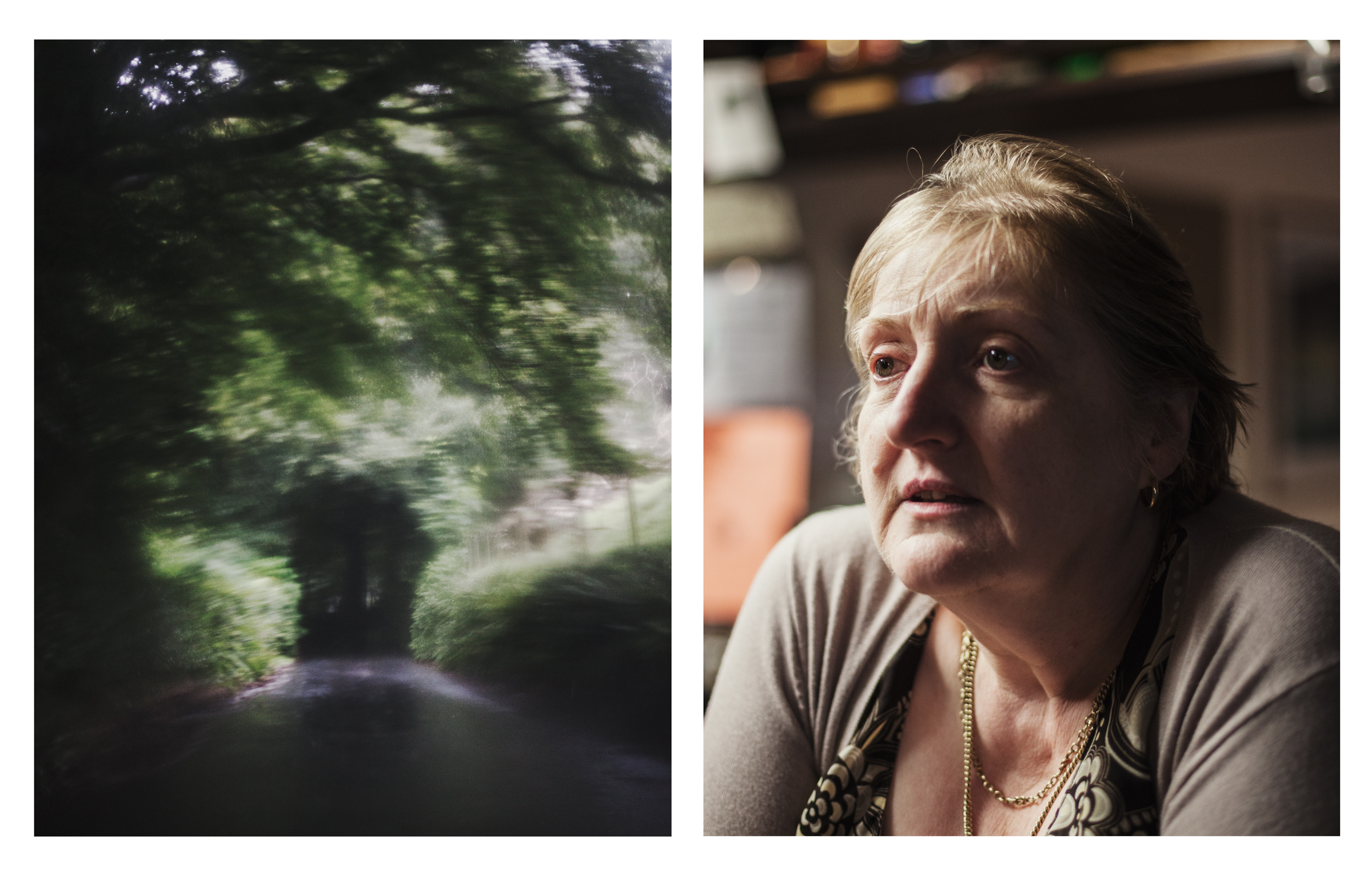
On our final night in Wales, we travel back to Llanddewi-Brefi for one last drink in the New Inn. I still want to chat to the pub landlady, and I find her exactly where we left her, perched on a stool behind the bar, pulling pints and occasionally flicking through an iPad.
She took over the pub 27 years ago, and has never strayed far. She knows every face here, and exactly where they live. When I ask her if she enjoys running the pub, she says, “I must do.” Her favourite part of the village is the sign, because when she sees it she knows she’s home. “The village,” she admits, “does seem to have some sort of… hold on people,” before muttering something about raves. What raves? “Illegal raves up the mountain.”
She describes hearing a commotion outside one Saturday night last June at around 10.30PM; honking horns, revving engines and people shouting. “All you could hear was ZOOM ZOOM ZOOM!” she says. She peered outside to find a scene one part Mad Max, two parts Only Fools and Horses, as an endless flurry of clapped-out vans and dodgy cars raced through the village and up the mountain. “Then the music started, and you could hear it from the village for days – BOOM BOOM BOOM!”
I search the internet for it on my phone and find a video on YouTube titled “UKTEK 2016 LLANDDEWI BREFI”. And there it is: hundreds of young people dancing and screaming in front of a sound system to a backdrop of lush pine forests, double inflated NOS balloons in their hands, tripping and ramming into each other as a DJ plays a hardstyle version of “Macarena”. The music has changed, the drugs have changed, and yet all these years on people still feel drawn to the exact same village in the vast Green Desert of Wales.
We leave the pub, walk into the carpark and look up. The astronomy website was right: a bullish Milky Way is out in full effect, splashed across the sky like a dropped ice cream. The stars aren’t twinkling, they’re roaring, and the moon is so bloated and overweight it looks like it might keel over. It’s absolutely fucking beautiful, and a thought as old as centuries drifts into my mind: maybe I should move to Llanddewi-Brefi.
Some names have been changed to protect anonymity
More VICE long reads:
Does Anyone Care That Camden Is Dying?
Why So Many People Are So Obsessed with Supreme
Sex Shops and Swingers Clubs: How the A1 Became Britain’s Sexiest Road
From https://www.vice.com

A terrific report from the sixties, proving once again, the best of the sixties is still to come. In stories like this. Great photos. Inspirational times, in deed; indeed!
Comment by Cy Lester on 18 January, 2018 at 3:14 pm